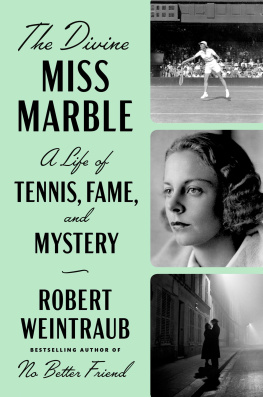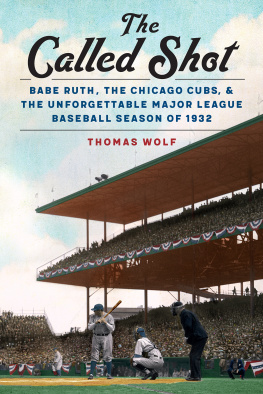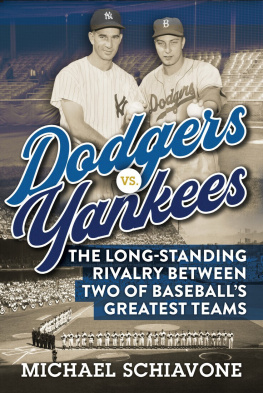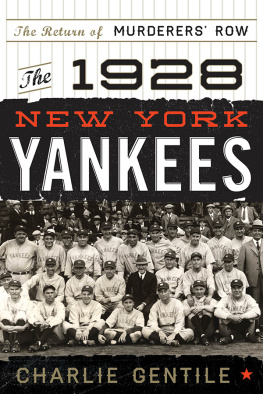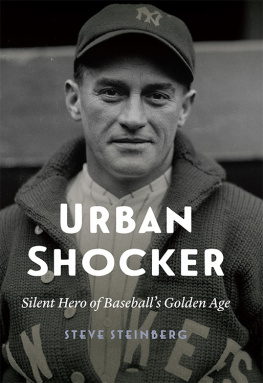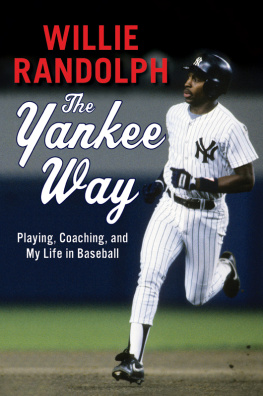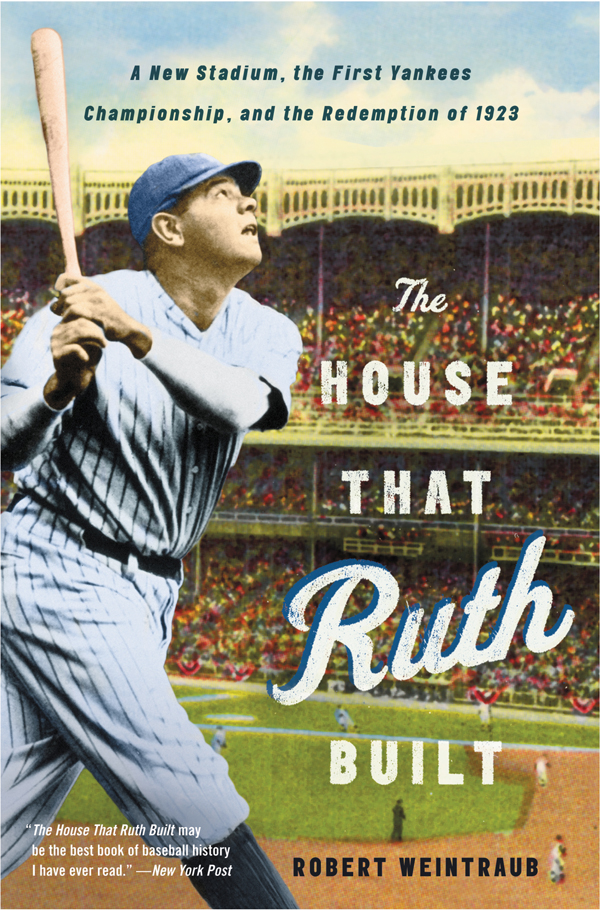
In accordance with the U.S. Copyright Act of 1976, the scanning, uploading, and electronic sharing of any part of this book without the permission of the publisher constitute unlawful piracy and theft of the authors intellectual property. If you would like to use material from the book (other than for review purposes), prior written permission must be obtained by contacting the publisher at permissions@hbgusa.com. Thank you for your support of the authors rights.
Thank you for buying this e-book, published by Hachette Digital.
To receive special offers, bonus content, and news about our latest e-books and apps, sign up for our newsletter.
Sign Up
Or visit us at hachettebookgroup.com/newsletters
Copyright 2011 by Robert Weintraub
Excerpt from The Victory Season copyright 2013 by Robert Weintraub
Cover design by Ploy Siripant, cover photo-illustration by Marc Yankus, cover photograph of Babe Ruth Mark Rucker / Transcendental Graphics / Getty Images; stadium The Image Works
Cover copyright 2013 by Hachette Book Group, Inc.
All rights reserved. In accordance with the U.S. Copyright Act of 1976, the scanning, uploading, and electronic sharing of any part of this book without the permission of the publisher constitute unlawful piracy and theft of the authors intellectual property. If you would like to use material from the book (other than for review purposes), prior written permission must be obtained by contacting the publisher at permissions@hbgusa.com. Thank you for your support of the authors rights.
Little, Brown and Company
Hachette Book Group
237 Park Avenue, New York, NY 10017
littlebrown.com
twitter.com/littlebrown
First e-book edition: April 2011
The publisher is not responsible for websites (or their content) that are not owned by the publisher.
The Hachette Speakers Bureau provides a wide range of authors for speaking events. To find out more, go to hachettespeakersbureau.com or call (866) 376-6591.
ISBN 978-0-316-17517-3
Praise for
Robert Weintraubs
The House That Ruth Built
Any debate about who the greatest baseball player of all time is starts and stops with Babe Ruth. If you hold that opinion it will be strengthened after reading Robert Weintraubs compelling and entertaining history of the 1923 season. Fascinating. Weintraub skillfully re-creates this dramatic and pivotal season.
Jody Seaborn, Austin American-Statesman
The House That Ruth Built may be the best book of baseball history Ive ever read.
Mike Vaccaro, New York Post
Just when you thought there were no great seasons left uncoveredor anything new left to say about Babe Ruthhere comes The House That Ruth Built. Robert Weintraub has reconstructed the 1923 season and shown how it changed baseball that season and every season after it. No previous writer has taken so much care to caulk the cracks in the years between Ruths final year as a pitcher with the Boston Red Sox in 1919 and the Yankees first World Series victory in 1923. Weintraub has a fine feel for period detail as well as the scope of what happened in 1923, when the Yankees, by beating the great John McGraws New York Giants, ushered baseball into a new era of long-ball glory. A perfect match of team, year, and writer.
Allen Barra, Newsday
A fascinating tale of one of baseballs greatest momentsthe emergence in 1923 of Babe Ruth and the Yankees. The research is meticulous and the writing is delightful. Get on the train with Babe and the boys. Youre in for a rollicking good ride.
Jonathan Eig, author of Luckiest Man: The Life and Death of Lou Gehrig and Opening Day: The Story of Jackie Robinsons First Season
Robert Weintraub beautifully details the building of the iconic park and the World Series in which Ruth became a legend.
Dick Kreck, Denver Post
The whole baseball year of 1923 is the frame for Weintraubs elegantly constructed narrative. There is no nickname ever used for a player that Weintraub overlooks nor any colorful phrase now common in baseball that he doesnt cite. A treasure for the fan who cannot get enough.
Booklist (starred review)
Weintraub enlivens his book with a cast of remarkable characters, starting with the Babe himself. A book about New York baseball in the 1920s, a sporting scene ripe with fascinating possibilities that Mr. Weintraub mines thoroughly for his spirited book.
Bob Hoover, Pittsburgh Post-Gazette
Weintraub is a very lively writer: he makes it all fresh and newly intriguing, adding in a whiff of Damon Runyons saltiness and introducing readers to some of the idioms of the era. Bracing and fun for all baseball buffs, whether or not fans of todays Bombers.
Library Journal (starred review)
Weintraub nicely infuses modern references into his 1920s descriptions. The book is comprehensive, and Weintraub details everything from the construction of the stadium and the careers of Ruth and McGraw to a detailed season overview and deconstruction of the 1923 World Series.
Publishers Weekly
The Victory Season
For my mother, Judith Weintraub, who always said,
I think you have a book in you.
The scar is still upon my heart from 1922
The blight is still upon my soul for what I failed to do
But now once more the battle cry comes sweeping down the plain
And I come with lifted mace to wipe away the stain
For though I fell as Lucifer in last years jamboree
Theyll find another Babe at bat in 1923.
Grantland Rice, The Babe Speaks, New York Tribune, October 8, 1923

J OHN M C G RAW NEVER learned to drive. Baseballs greatest manager usually got around the city by automobile, driven by his chauffer, James Thompson. But October 10, 1923, was a mild Indian summer morning, pushing sixty degrees just before eleven when the leader of the New York Giants stepped onto the sidewalk outside the Polo Grounds. McGraws destination was only a short stroll from here, five or ten minutes at most, so he waved Thompson away and decided to walk.
McGraws players emerged from the ballpark behind him, hauling the tools of their tradegloves, bats, spikesand jumped into a fleet of waiting cabs, two or three men to a car. They were ready for action, especially since todays matchup was the first game of the 1923 World Series. But it was not a home game. For the first time in three seasons the Fall Classic wasnt being played entirely on the sporting green of the Polo Grounds.
McGraw wore a tailored suit rather than his uniform. All summer he had worn the flannel togs, but come fall he switched to civvies. He was quite warm as he walked the short, steep distance up to Eighth Avenue. The cabs bearing his players sped past. The Polo Grounds sat in Coogans Hollow, a swale of land under Coogans Bluff, a ridge overlooking the Harlem River and named for James J. Coogan, the onetime Manhattan borough president who owned the land until his death in 1915. The park was at the corner of West 155th Street and Eighth, putting it on the northeastern edge of Harlem. Immediately to the west, the posh neighborhood known as Sugar Hill (Duke Ellingtons destination in Take the A Train) was just beginning to show the fruits of the epoch known as the Harlem Renaissance, thanks to a boom in black artists, writers, thinkers, and (perhaps most significantly) organized gamblers. Known as bankers, they had just introduced a craze called the Numbers that was sweeping the area like wildfire.
Next page

